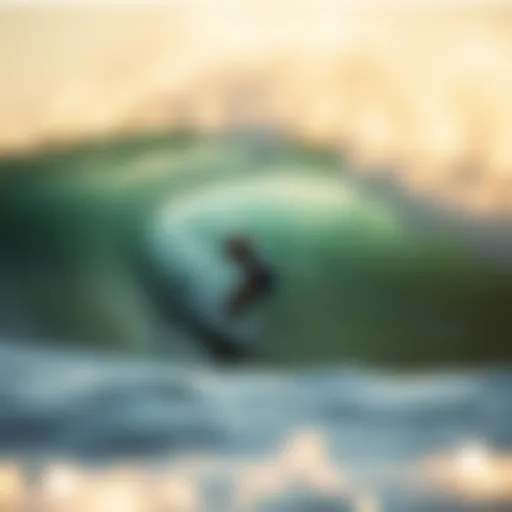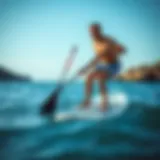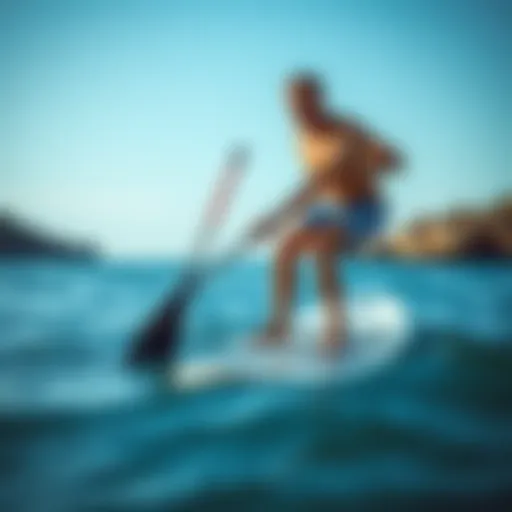Beginner Kite Surfing: Essential Insights and Tips
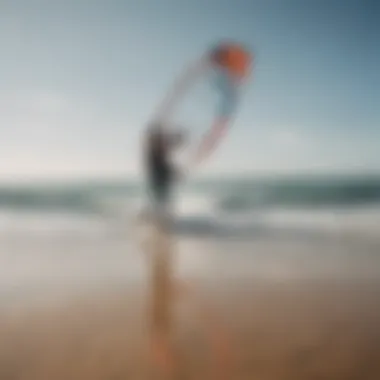

Intro
Kite surfing is more than just a sport; it's an exhilarating blend of surfing and flying, where the thrill of harnessing the wind propels you across the water's surface. For those dipping their toes into this exciting activity, understanding the basics is pivotal. Whether you are drawn in by the breathtaking acrobatics or the sheer joy of gliding over waves, this guide seeks to arm you with the knowledge to set sail with confidence.
The journey into kite surfing begins with grasping the essential gear and equipment, as this forms the cornerstone of your initial experience. From the kite itself to the board you stand on, every piece of equipment plays a vital role in your safety and enjoyment. The wind conditions, local regulations, and even the environment around you also hold significant weight in your kite surfing adventure. It's not just about mixing it up on the water; it's about understanding the nuances that come along with it.
This guide aims to peel back the layers of information regarding kite surfing. We'll explore the essential topics that every beginner ought to familiarize themselves with. By paying attention to gear, safety measures, and fundamental techniques, you'll have a structured roadmap to navigate your entry into the kite surfing world.
Let’s start by taking a closer look at the key gear and equipment needed for your kite surfing escapade.
Surf Gear and Equipment
Understanding what equipment is essential for kite surfing is akin to knowing which shoes to wear for a hike. It's vital to select the right tools to enhance your experience and minimize risks.
Kite Selection
Choosing a kite is not a simple task. It's essential to factor in size, style, and even the wind conditions you plan to tackle. Kites come in various shapes and sizes:
- Freviform Kites are best for beginners since they provide stability and are easier to control.
- C-Kites excel in performance but may not be the easiest for a newcomer.
Selecting the right kite size should hinge on your weight, the wind speed, and your experience level. Generally, larger kites fly better in lighter winds, while smaller kites work best when conditions are gusty or windy.
Latest Surfboard Technologies
After selecting your kite, the next piece of the puzzle is the board. Boards vary extensively: from directional boards for riding waves to twin-tip boards designed for those just starting. Modern advancements have led to materials like carbon fiber being used, which are durable yet lightweight. Whether you're planning to surf or just cruise along, the right board provides the balance and control you need.
Here are key features to consider:
- Stiffness: A stiffer board provides more speed and pop, which is great for tricks, while a softer board offers more comfort on choppy water.
- Length and Width: Shorter boards are generally easier to maneuver while larger boards provide more stability.
Essential Accessories for Surfers
No kitesurf adventure is complete without the right accessories. Safety gear, such as a helmet and impact vest, should not be optional choices. Likewise, a harness serves to connect you to the kite, offering control and reducing strain on your body. Choosing the right type of harness, whether it be sit or waist, can greatly influence your comfort while out on the water.
Additionally, consider the following:
- Leash: A quality leash is essential to ensure your board stays close if you fall.
- Safety Knife: In emergencies, having a handy safety knife can make a crucial difference.
"The best equipment is only as good as the understanding of how to use it."
The foundation of your kite surfing journey is built on the right gear, which enhances not just your performance but also your safety. By discerning the myriad of choices out there, you’ll find the best setup tailored to your aspirations.
Having discussed gear, it’s imperative we delve into the vital techniques and skills you need when hitting the water.
Understanding Kite Surfing
Kite surfing represents a thrilling fusion of wind, water, and waves, making it a highly sought-after sport among adventure lovers. Grasping the concepts behind kite surfing is not just about strapping on a board and holding onto a kite; it involves a deeper appreciation for the nuances of the environment and the equipment itself. Understanding kite surfing sets the stage for safe and enjoyable experiences on the water.
Defining Kite Surfing
Kite surfing, at its core, involves riding a board while being pulled across the water surface by a large controllable kite. Picture this: you are on a breathtaking beach, the sun glistening on the waves, and your kite soaring above you, dancing with the wind. This active sport combines elements of surfing, windsurfing, and paragliding. Unlike traditional surfing, where one relies solely on ocean waves, kite surfers harness the power of the wind through their kites, making it a versatile activity favorable in various conditions.
The kite's size and design directly influence performance, and it’s essential for beginners to select a kite suitable for their weight and wind conditions. This understanding ensures that novices can enjoy the thrill without being overwhelmed. Not only does kite surfing provide an adrenaline rush, but it also nurtures a profound connection with nature as surfers learn to read the wind and water.
Evolution of Kite Surfing
Kite surfing has a rich and fascinating history that charts its evolution from early kiting experiments to the fast-paced sport it is today. The origins of kite surfing can trace back to various forms of kiting in the 1970s and 1980s. Some innovations emerged from individuals tinkering with kites for recreation, while others were built for practical purposes like fishing or sailing.
As these early kite sports gained traction, those pioneering enthusiasts began experimenting with different kite designs and harnessing techniques. This led to the birth of what we now recognize as modern kite surfing in the 1990s. Notably, the introduction of inflatable kites revolutionized the way people approached the sport, making it safer and more accessible to a wider audience.
Many local communities started to form around the sport, nurturing a culture of camaraderie and support. The progressive improvements in materials and technology coupled with a growing emphasis on safety have catapulted kite surfing into a mainstream activity. Today, it's not uncommon to spot kite surfers carving through the waves along beaches worldwide, a testament to its universal appeal.
Understanding these foundations of kite surfing not only enhances one’s engagement with the sport but also cements the relevance of community and progress within it. As we dive deeper into this guide, the emphasis will continuously return to how crucial it is for beginners to be mindful of their choices, their equipment, and their environment.
Essential Equipment for Beginners
In kite surfing, the right gear forms the backbone of a successful and enjoyable outing on the water. Choosing the correct equipment not only maximizes performance but also ensures safety and enhances the overall experience. The world of kite surfing is filled with options, making it essential to understand what to prioritize. This section will delve into the key components of beginner kite surfing gear, focusing on the kite, harness, board, and safety equipment.
Kite Selection
Choosing the right kite is akin to selecting a reliable vehicle for a long road trip. You wouldn’t dream of hitting the highway without knowing that your car can handle the terrain, right? Similarly, the kite must match skill level and style. Beginners often benefit from larger kites because they generate more lift, which helps in staying on the surface of the water, especially in lighter winds.
Here are a few key considerations:
- Size Matters: Typically, a kite between 9 and 12 meters is suitable for lighter-weight riders, while heavier riders might select something slightly larger. The wind conditions also dictate kite size; more wind requires smaller kites.
- Foil vs. Inflatable: Inflatable kites are common for beginners due to their stability and ease of use. Foil kites, while efficient in certain conditions, require more experience and are better suited for advanced riders.
- Type of Kite: All-terrain kites offer versatility for different conditions, which is great for novices still figuring out where they thrive.
Harness and Control Systems
A harness is that much-needed link between you and the kite, making its choice critical. It distributes the pull of the kite evenly across your body, offering comfort and control during the ride. Different types exist—seat harnesses, waist harnesses, and even board short attachments. Beginners generally find seat harnesses to be the most forgiving as they provide lower back support and prevent the kite from pulling them off-balance.
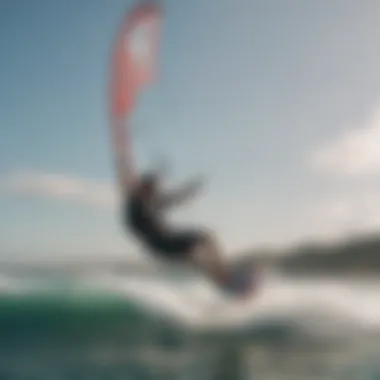

Then comes the control system. This comprises the lines and bar that allow you to steer the kite.
- Bar Width: Beginners should opt for a bar that feels comfortable in their hands. A wider bar may give more leverage but can also feel cumbersome.
- Safety Systems: Look for a harness and bar combo with effective safety mechanisms in place, like quick release options that allow the line to disengage in emergencies.
Boards for Beginners
Selecting the right board is another cornerstone of your kite surfing journey. Much like a shoe that fits right, a good board can considerably enhance your comfort and performance on the water. For novices, a more buoyant board is preferable, as it helps maintain stability and allows for easier maneuvering.
Here are some pointers:
- Size and Shape: Larger boards provide a better surface area for early glide, making it easier to get up and stay afloat. Look for a shape that offers good rocker—this helps in carving through the water.
- Material Matters: Many beginner boards are made from durable materials that withstand the wear and tear of learning without excessive impact on performance.
- Fin Configuration: Most beginner boards come with four fins, which can greatly help in maintaining direction as they offer more grip in the water, assisting with control.
Safety Gear Overview
Being equipped is not just about performance; it’s about staying safe while you’re at it. Kite surfing can entail risks, especially for those fresh to the scene. Thus, safety gear should never be an afterthought.
- Helmets: A protective helmet can be crucial, shielding your head from unexpected impacts.
- Impact Vests: Besides comfort and added floatation, impact vests can prevent injuries during hard falls.
- Safety Leashes: These are essential connections that prevent the kite from drifting away if you lose hold of the bar. Always check their reliability.
"An ounce of prevention is worth a pound of cure." Not only true for health, but it rings specially loud and clear in the realm of extreme sports.
Overall, understanding the essential equipment for kite surfing goes a long way in ensuring that you find joy in the sport. Selecting a kite, harness, board, and safety gear tailored for beginners will set a sturdy foundation and prepare you for the exhilarating winds ahead.
Safety First: Precautions Needed
When delving into the world of kite surfing, safety isn’t just a guideline�—it’s the backbone of this thrilling sport. Ignoring safety measures can not only lead to accidents but can also cast a shadow over the enjoyment of kite surfing itself. No one sets out to harm themselves; hence, being aware of specific precautions can significantly enhance the experience. Emphasizing on safety can ensure a smoother, more enjoyable time on the water and build confidence in your abilities.
Understanding Wind Patterns
A kite surfer is only as good as their ability to read the wind. Understanding wind patterns is crucial, as it dictates both the performance of the kite and the safety of the session. Every kite surfer should develop a keen eye for assessing wind conditions; this involves gauging not only the strength of the wind but also its direction and possible gusts.
To gain insights into wind, one can:
- Observe Local Conditions: Notice how the trees and flags behave. A gentle sway suggests lighter winds, while vigorous flapping indicates stronger gusts.
- Use Wind Forecast Apps: Smartphones have made it easier than ever to keep track of wind speed and direction, ensuring you're prepared before hitting the water.
- Check for Offshore Winds: Be wary as offshore winds can shift unexpectedly, leading you further out to sea.
Adapting to different wind patterns is like knowing the tide; it can save you from potential trouble.
Emergency Procedures
Accidents can happen, and being ready for unexpected scenarios can make all the difference. Familiarize yourself with emergency procedures well before you need them. Here are critical steps every beginner should keep in mind:
- Know Your Gear: Make sure you understand how to quickly depower or release your kite. Each piece of equipment has its mechanism—knowing it is non-negotiable.
- Establish a Buddy System: Kite surfing is more enjoyable and safer with a partner. Stay close to one another and bail each other out during emergencies.
- Practice Self-Rescue Techniques: Understanding how to safely get back to the shore if things go wrong can be lifesaving.
- Identify Safe Zones: Prior to launching, locate where you can go for help, should you need it.
Having a plan in place saturates your session with a sense of security and enjoyment.
Kite Surfing Etiquette
Adopting proper etiquette reflects respect for the environment, fellow surfers, and onlookers. Kite surfing imparts a sense of community, and maintaining decorum signals your place in it.
Some etiquette tips to follow:
- Respect Others' Space: Avoid cutting too close to other kite surfers. Maintaining a safe distance helps prevent accidents that could lead to injuries.
- Yielding Rights: Know when to yield, particularly to surfers who are riding downwind of you. It’s the golden rule of water sports—don't be the one who causes a mishap.
- Communication is Key: Use hand signals or verbal cues to alert others of your intentions. Communication helps avoid misunderstandings when on the water.
- Clean Up After Yourself: This might sound trivial, but leaving the beach cleaner than you found it signifies respect for the environment. Plus, it sets a good example for others.
"Safety is not a gadget, but a state of mind."
Taking safety seriously isn’t just about following rules; it's creating a mindset that prioritizes care and responsibility while navigating the exhilarating world of kite surfing.
Learning the Basics: Initial Steps
When diving into kite surfing, one must recognize that starting with a strong foundation is paramount. Just like learning any sport, the initial steps build the essential skills and knowledge that will guide you through your journey in the waves. Getting these basics right doesn’t just speed up your progress; it may very well mean the difference between having a delightful experience on the water and facing potential frustrations or even dangers.
Finding the Right Location
Selecting the right spot to practice kite surfing is crucial for beginners. Not every beach or windy area is suited for newcomers. Look for places with ample space, minimal obstructions, and more importantly, consistent wind. Dedicated kite surfing spots often have instructors, equipment rentals, and designated launch areas, which can make all the difference in accommodating learners.
Ideal locations should have the following considerations:
- Wind Conditions: Seek areas with steady winds around 10 to 20 knots. Too little wind and the kite won't fly; too much can make handling difficult.
- Water Depth: Shallow waters (knee-high) are perfect for learning. They offer safety when you fall and make getting back up easier.
- Crowd Levels: Choose times when the beach is not swarming with other surfers. This not only enhances safety but also allows for focused practice without distraction.
- Safety Measures: Familiarize yourself with the local rules and regulations. Some beaches have specific zones that are safer for kite surfing.
Thus, take the time to scout various locations, your journey depends heavily on the space and environment you choose.
Basic Techniques to Master
Once you’ve found a suitable location, it's time to grasp the fundamental techniques of kite surfing. Knowing these techniques will empower you to confidently control your kite and board, setting the stage for further skill advancement. Here are some key skills to focus on:
- Kite Control: Learning how to handle the kite on the ground and in the air is the first major hurdle. Practice flying the kite while standing on the beach. Feel how it responds to your movements and the wind.
- Body Dragging: This skill helps you get accustomed to water dynamics while attached to the kite. It teaches you how to maneuver through the water, which is essential for getting back to the board and more importantly, for safe progress in turbulent conditions.
- Water Launching: Once you feel comfortable, practice launching the kite from the water. Work on positioning yourself correctly and coordinating your movements.
- Board Start: After mastering the above, the next step is attempting to stand on the board. It can be tricky as it requires balance and timing with the kite's pull. Remember, practice makes perfect; don't rush it.
- Fall and Recover: Don’t ignore the importance of mastering how to fall safely and recover when things go awry. It’s a natural part of learning; you’ll take spills now and then.
- Power Zones: Understand where the kite generates the most pull. This knowledge is crucial before going into the water.
Navigating through these initial techniques might seem challenging, but take a breath, trust the process, and keep the lines of communication open with your instructor or more experienced kitesurfers.
"The journey of a thousand miles begins with a single step." – Your kite surfing adventure starts here.
The Importance of Professional Training
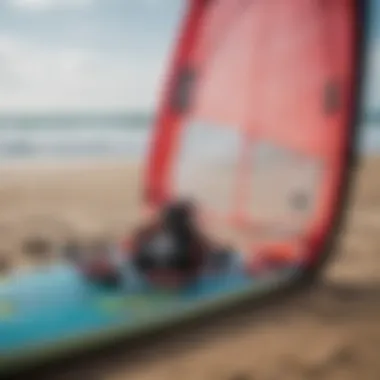

When it comes to kite surfing, just like diving into the ocean's blue waves, you better know your craft before setting sail. Professional training isn’t merely a suggestion; it’s a cornerstone of safely mastering this exhilarating sport. The sea can be as unpredictable as a cat on a hot tin roof, and being equipped with the right knowledge not only enhances your skills but also ensures your safety and the safety of those around you.
Learning kite surfing through professional instructors aids beginners in grasping essential techniques and safety protocols that might not be immediately apparent. From understanding how to handle the kite in different wind conditions to getting a grip on board control, trained professionals offer first-hand experience that can fast-track your learning process. This guidance helps avoid common pitfalls that many self-taught novices often face.
Choosing an Instructor
When it comes to choosing an instructor, several factors come into play. A great instructor can make the difference between belly-flopping or gracefully catching the wind. It's not just about picking a name off the list; you want a reputable individual or organization. Here’s what to consider:
- Certifications: Look for instructor certifications recognized by organizations like the International Kiteboarding Organization (IKO) or the British Kitesurfing Association (BKSA). These credentials are indicative of proper training and safety measures.
- Experience: An instructor with years under their belt often has refined methods to impart knowledge more effectively. Their experience means they’ll likely have a bag of tricks for overcoming common challenges.
- Reviews and Testimonials: Dig into what former students say. A word from the wise can go a long way. Positive feedback often signals a good choice.
- Teaching Style: Everyone learns differently. Some people appreciate a more hands-on approach, while others prefer a more theoretical basis first. When you’re looking for an instructor, try to find out how they align with your own learning style.
Finding the right fit can help ensure a smoother experience and a deeper understanding of kite surfing principles.
Typical Training Progression
Once you’ve settled on a qualified instructor, the training will typically unfold in a series of steps designed to build your confidence and competence incrementally. Here’s a peek at what to expect:
- Theory Lessons: Before ever touching the equipment, you’ll likely dive into theory. This might cover wind measurements, equipment setup, and basic safety protocols. Understanding these concepts lays a solid foundation.
- Ground Handling: This phase usually involves getting comfortable with your kite while on land. You’ll learn how to launch and land, as well as how to control the kite without being on the water. This stage is crucial, as it helps you grasp the kite’s behavior, which varies with wind speed.
- Water Lessons: With the groundwork laid, it’s time to hit the water. Here, you’ll start with body dragging, allowing you to understand the kite's pull while being towed through the water, without the board. It’s a key step in terms of safety and confidence.
- Board Skills: Once you’re comfortable controlling the kite and knowing how to maneuver through the water, you will start using the board. This progression can sometimes feel like jumping from a bicycle to a motorcycle—one moment you’re just learning to ride, and the next you’re trying to balance two moving parts.
- Independent Riding: The final stage involves practicing on your own under the close observation and support of your instructor. You’ll start to develop your unique style and enjoy the thrill of kite surfing as you become more adept at reading the water and conditions around you.
"Training not only sharpens your skills but creates awareness that can save lives—yours and others'."
Practicing with a professional ensures you don't just become a kite surfer, but a smart kite surfer—one who respects the ocean and understands its nuances. Commitment to professional training is not just about learning the ropes; it's about cultivating the safest and most enjoyable experience in a world that rewards respect and knowledge.
Common Challenges for Beginners
Kite surfing is not just about catching the wind and riding the waves; it is also a journey fraught with challenges that every newcomer must face. Understanding these hurdles is crucial for an enjoyable and safe experience. By tackling common challenges head-on, beginners can foster resilience, improve their skills, and gain the confidence necessary to truly embrace this thrilling sport.
Physical Fitness Requirements
While kite surfing offers an exhilarating experience, it demands a certain level of physical fitness that beginners should not overlook. This sport is not as simple as hopping on a board; it requires strength, flexibility, and endurance. Kite surfers frequently battle strong winds and waves, making muscle strength essential for handling the equipment effectively.
- Upper Body Strength: The act of controlling the kite necessitates significant strength from the shoulders, arms, and back. Beginners can benefit from exercises focused on upper body strength, such as push-ups and resistance training.
- Core Stability: A strong core helps maintain balance while navigating the board. Incorporating core exercises like planks and Russian twists can lay a solid foundation for effective maneuvering.
- Leg Muscles: The legs play a vital role in stability and agility. Squats and lunges are excellent for building the necessary muscle to endure the varied terrains you may encounter.
A minimum fitness level can make your kite surfing experience more enjoyable and less taxing. Moreover, injury risk decreases when a person is fit.
Dealing with Setbacks
Every kite surfer will experience setbacks, especially as a beginner. Whether it’s crashing the kite or winding up in a less favorable position on the water, these moments can frustrate the best of us. However, learning how to navigate these challenges can foster growth and confidence.
- Embrace Mistakes: Everyone starts somewhere, and mistakes are part of the process. Rather than feeling defeated, view each mistake as a learning opportunity. Reflect on what went wrong and how you can adjust in the future.
- Take Breaks: The ocean can be unforgiving, and pushing oneself can lead to fatigue or injuries. When feeling overwhelmed, the best course of action is to take a step back. Allow yourself to regroup—this might be the best way to clear your mind and broaden your perspective.
- Stay Connected with Others: Engage with the kite surfing community. By sharing experiences, learning from seasoned surfers' mistakes can provide valuable insights and reassurance for beginners.
"The beauty of kite surfing lies not just in the smooth rides, but in learning to weather the storms."
By understanding the physical demands and being prepared for inevitable setbacks, beginners can cultivate a more robust and enduring relationship with kite surfing. It’s about grasping those exhilarating moments, while also learning and growing from the tougher ones.
Long-Term Skill Development
The journey of kite surfing is not merely about mastering technique; it's also about nurturing a mindset geared towards continuous improvement and engagement with the broader community. Long-term skill development in kite surfing combines a focus on progression, safety, and adaptation to various conditions, which is crucial for anyone wishing to become a competent kite surfer. Beyond merely standing on the board, the goal is to evolve into a skillful rider capable of navigating different environments and challenges.
First, let's consider progressing beyond the basics. Many beginners often feel a sense of triumph after their first successful rides. However, at this juncture, one must recognize that this feeling is just the tip of the iceberg. To unlock the full realm of kite surfing, it's essential to learn advanced techniques and maneuvers. This includes tackling jumps, tricks, and even downwinders — practices that may seem daunting at first.
- Advanced Skills Training: This is where having a skilled instructor or experienced friends becomes invaluable. They can provide direction and tips on improving your technique. Video analysis of your kite surfing can also illuminate areas for improvement.
- Practicing Various Conditions: Each session in different wind and wave setups can enhance adaptability. This is vital; the conditions are rarely perfect, and learning to maneuver in rougher waters will boost your confidence.
Regular practice, reflection, and adaptation are key to ongoing skill development. Setting personal goals, such as completing specific maneuvers or joining competitive events, can foster a disciplined training approach.
Never stop learning. Every session on the water is an opportunity to refine your skills and broaden your understanding of kite dynamics.
Next, engaging with the community plays a vital role in long-term skill development. Kite surfing is more than just a sport; it’s a culture filled with resources, camaraderie, and shared experiences. By integrating into this community, you can accelerate your learning in several ways:
- Joining Local Clubs: Many regions have local kite surf clubs offering group training sessions, organized events, and competitions. This fosters camaraderie and encourages shared knowledge.
- Online Forums: Websites like Reddit have active discussions where you can ask questions or share experiences.
- Workshops and Events: Participating in workshops led by pros or attending local meetups gives you exposure to varying techniques and insights that can sharpen your skills.
- Social Media Connections: Platforms like Facebook host groups dedicated to kite surfing that facilitate networking and knowledge exchange.
Finding others who are also on their kite surfing journey helps maintain motivation and provides the solidarity vital for overcoming challenges.
Overall, engaging actively in both skill refinement and community interaction enriches the kite surfing experience. This combination of personal growth and community involvement not only makes kite surfing more enjoyable but also enhances your abilities, ensuring a rewarding journey on the water.
Environmental Considerations
Exploring the joy of kite surfing comes with a responsibility to respect the marine environments and ecosystems that we enjoy. As a beginner, understanding environmental considerations is crucial for ensuring that the thrill of the sport doesn’t come at the expense of our precious natural habitats. This segment dives into how kite surfing impacts marine life and presents practical sustainable practices that every enthusiast can adopt.
Impact of Kite Surfing on Marine Life
Kite surfing poses unique challenges to marine ecosystems. The presence of kite surfers in certain areas can disrupt local wildlife, particularly in regions where sensitive habitats exist. For instance, shorebirds, nesting sea turtles, and other marine creatures may feel threatened by kite surfers, causing them stress and leading to changes in their natural behavior. Materials from the kites and lines, if discarded, can also contribute to pollution in the ocean, harming marine species.
Some adverse effects to consider include:
- Noise Pollution: The sound produced by kites and boards can interrupt the communication patterns of marine animals.
- Physical Damage: Well-placed launches and landings can damage fragile coastal regions and coral reefs.
- Habitat Disruption: Increased foot traffic and human activity can disturb nesting sites and breeding grounds.
Being aware of these impacts helps kite surfers make informed decisions, hence preserving both enjoyment and environmental integrity.
"Every time you enter the water, you're stepping into a world that is not just yours, but is shared with many other creatures. Respect it."
Sustainable Practices for Enthusiasts
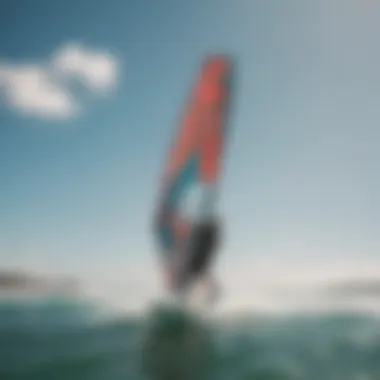

Incorporating sustainable practices into kite surfing doesn’t have to be complex or burdensome. It often revolves around conscious choices that can significantly lessen our footprint. Here are some strategies every kite surfer should keep in mind:
- Leave No Trace: Clean up after yourself. Always pick up trash and avoid leaving any equipment behind.
- Choose Eco-friendly Equipment: Invest in kites and boards made from sustainable materials or brands known for their environmental commitments.
- Educate Yourself: Familiarize yourself with the marine life in your surfing area. Knowledge about local species can guide you in making better decisions while on the water.
- Respect Wildlife: Avoid areas known for wildlife activity, particularly during critical seasons like nesting or migration.
- Participate in Clean-up Initiatives: Many surf communities organize beach clean-up days. Joining these initiatives fosters a sense of camaraderie and responsibility among fellow surfers.
In summary, kite surfing offers exhilarating experiences but does not come without consequences. By understanding its impact and adopting sustainable practices, we contribute to a thriving environment for both marine life and future kite surfers.
Kite Surfing in Popular Locations
Kite surfing is not only about the thrill of gliding across the water; it's also about the places you do it. Picking the right location is fundamental to your success and enjoyment. The perfect spot combines factors such as wind conditions, water type, and local culture. This section explores what makes certain places iconic for kite surfing and how to find venues that suit your level of experience and preference.
Identifying Ideal Destinations
When it comes to kite surfing, not all beaches are created equal. Here are some key points to consider:
- Wind Consistency: A good location should provide steady winds. Locations like Tarifa, Spain or Cabarete in the Dominican Republic are known for their reliable wind conditions most of the year.
- Safety: It’s vital to choose spots that cater to both experienced and beginner surfers. Areas with clear safety protocols and lifeguard presence can make a significant difference.
- Amenities: Access to facilities like gear rentals, schools, and local shops is also important. A well-equipped beach can ensure you have everything you need for a safe and enjoyable kite surfing experience.
Popular Kite Surfing Spots
Some exemplary locations include:
- La Ventana, Mexico: Renowned for its warm water and consistent wind, it’s a favorite among many enthusiasts.
- Hatteras, North Carolina: Known as the kiteboarding capital of the East Coast, it offers a variety of conditions for all levels.
- Cumbuco, Brazil: With its beautiful lagoons and steady trade winds, it's a prime location for kite surfers looking to immerse themselves in local culture.
When searching for your own ideal spot, you want to look at these criteria and see which places tick all the boxes for your kite surfing adventure.
Cultural Insights from Various Regions
Diving into kite surfing in various regions reveals not just breathtaking landscapes, but unique cultures that enhance the overall experience. Here are some insights:
- Community and Connection: In regions like Tarifa, Spain, kite surfers form a tight-knit community that celebrates the sport and welcomes newcomers. This peer support can be invaluable as it eases apprehension when getting started.
- Respect for Nature: Locations such as Thulusdhoo in the Maldives emphasize environmental responsibility. Surfers and locals work together to maintain the integrity of the marine ecosystem, highlighting the importance of sustainable practices in our sport.
- Local Culture and Traditions: Areas like Cape Town, South Africa, offer a rich cultural experience outside of kitesurfing. The mixed heritage of the city enriches the surfer's journey, turning a sports trip into a cultural exploration.
"Kite surfing is more than just a sport; it’s a passport to new communities and cultures worldwide."
These insights can prepare you not just for the physical aspects of kite surfing but also for cultural interactions that can greatly enhance your trip.
Overall, understanding the significance of location will not only guide you in your initial learning stages but will also shape your experiences in the kite surfing world as you embrace the lifestyle. Each area presents unique opportunities for personal growth and adventure.
Integrating Kite Surfing into a Surfing Lifestyle
Kite surfing isn't just a sport; it's a thrilling lifestyle that beckons those ready to embrace the wind and waves. Integrating kite surfing into your daily life can amplify your experiences not only on the water but also off it. This seamless connection with surf culture opens doors to an array of activities, communities, and personal growth opportunities, all stemming from this adrenaline-soaked pursuit.
Intersection with Other Surf Sports
Kite surfing sits comfortably alongside other surf activities like windsurfing, paddle boarding, and traditional surfing. Each of these sports offers a unique perspective on the water, yet they share common themes: wind awareness, wave riding, and equipment mastery. By participating in these various surf sports, you can diversify your skill set and enhance your overall surfing experience.
For instance, learning to windsurf can improve your board handling skills, which proves beneficial when riding a kite board. Likewise, techniques gathered from traditional surfing, like reading waves and positioning yourself effectively, can enrich your kite surfing skills. Here are a few advantages of blending these experiences:
- Skill Enhancement: Each sport contributes to a deeper understanding of water dynamics.
- Community Connections: Cross-participation often leads to friendships across sports disciplines.
- Access to New Locations: Different activities may allow you to surf in varied environments.
By engaging in multiple surf sports, you become part of a larger tapestry of ocean enthusiasts, learning from diverse approaches and respecting the ocean's whims.
Balancing Kite Surfing with Travel Plans
When wanderlust strikes, it’s essential to blend your passion for kite surfing with your travel aspirations. Selecting destinations known for their kite surfing spots, such as Cape Town, Tarifa, or Maui, can perfectly merge adventure with pair enjoyment. However, combining kite surfing with travel requires some thoughtful planning.
Here are several considerations to ensure a smooth experience:
- Research Conditions: Understanding local wind patterns and wave heights can make or break your trip. Each spot has its secret sauce for ideal kite surfing conditions.
- Travel Gear: Make sure your travel kit includes essential kite surfing gear. Compact, lightweight equipment can save you hassle and allow for more comfortable travel.
- Join Local Spots: Connect with local kite schools or surf communities to enhance your experience. Meeting fellow surfers can offer insider tips on the best spots, gear rental locations, and even potential buddies for a session.
Traveling with your kite gear may seem daunting, but the thrill of kite surfing in new places adds excitement to any journey.
**"The ocean stirs the heart, inspires the imagination, and brings eternal joy to the soul." - Wyland
Future Trends in Kite Surfing
As kite surfing continues to ride the wave of popularity, understanding the trends shaping its future is crucial for beginners and seasoned enthusiasts alike. These developments not only enhance the overall experience but also foster a more inclusive and innovative community. The significance of being aware of these trends lies in their potential to impact equipment selection, skill development, and even environmental stewardship. This section explores key aspects that highlight how the sport is evolving and what it means for participants at all levels.
Technological Innovations
Recent years have seen a surge in technological advancements in kite surfing, fundamentally changing how the sport is experienced. Smart materials and design innovations have made kites lighter and more durable, thus improving performance in various wind conditions. For instance, some modern kites are equipped with sensors that can relay real-time data on wind speed and direction, helping riders make informed decisions on the water. Moreover, advances in control systems now allow for more precise maneuvers, creating smoother rides and enhancing safety.
Examples of these technologies include:
- Inflatable kites: Lighter and easier to handle, suitable for beginners.
- One-pump systems: Streamline the inflation process, saving valuable time for kite surfers eager to hit the waves.
- Adaptive kite designs: Enhance stability and responsiveness as kite surfers navigate through changing weather conditions.
The benefits of these innovations extend beyond individual performance. They also attract a broader demographic, as newcomers are less intimidated by the gear and learning curve. With user-friendly equipment readily available, even those unfamiliar with the sport can find themselves gliding across the water in no time.
Changing Demographics of Participants
As kite surfing gains traction around the globe, the makeup of its participants is changing significantly. Once predominantly popular among young thrill-seekers, the sport is witnessing an influx of diverse groups. It isn't just the age that’s changing—individuals from various backgrounds are showing interest, including families, older adults, and women. This shift means that the culture surrounding kite surfing is becoming more inclusive and balanced.
With a focus on community engagement, many schools and clubs now offer tailored programs that cater to these new demographics. For women, there are events and groups specifically aimed at encouraging participation, while families can benefit from lessons that include both parents and children. This is an exciting time for the sport, as embracing diverse participants fosters growth and innovation across all aspects of kite surfing.
"As the kite surfing community becomes more diverse, the impact of collective creativity and experience can lead to new ideas, trends, and a broader acceptance of various styles and practices."
The changing demographics also come with new expectations regarding safety and environmental considerations. Beginners are more conscious of the impact their activities have on local ecosystems, pushing brands and instructors to adopt practices that promote sustainability. Empathy towards the environment is becoming part of the kite surfing ethos, ensuring the sport can be enjoyed for years to come.
In summary, keeping an eye on future trends in kite surfing offers valuable insights for both new and experienced participants. The advancements in technology and the evolving demographics of riders are setting the stage for a thrilling era in kite surfing, one that promises to be as diverse and vibrant as the ocean itself.











